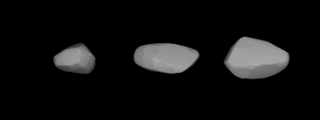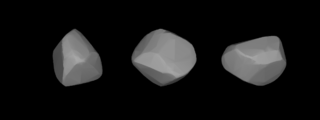Related Research Articles

Hedda is a sizeable Main belt asteroid. It is a C-type asteroid, meaning it is primitive in composition and dark in colour. This asteroid was discovered by Johann Palisa on October 17, 1879, in Pola and was named after Hedwig Winnecke, wife of astronomer Friedrich A. T. Winnecke.

Oceana is an asteroid from the asteroid belt. It was discovered by Austrian astronomer Johann Palisa on 30 March 1882, in Vienna. It was named after the Pacific Ocean. Based upon its spectrum, it is classified as an M-type asteroid, but is not metallic.

Weringia is a typical main-belt asteroid. It was discovered by Johann Palisa on 19 July 1882, and was named after Währing, part of Vienna, the city where the asteroid was discovered. Photometric observations during 2008 showed a rotation period of 11.1496 ± 0.0009 hours and a brightness variation of 0.20 ± 0.02 in magnitude.

Vindobona is a large Main belt asteroid. It was discovered by Austrian astronomer Johann Palisa on September 10, 1882. Vindobona is the Latin name for Vienna, Austria, the city where the discovery was made.
Russia is a large Main belt asteroid. It is classified as a C-type asteroid and is probably composed of primitive carbonaceous material. It was discovered by Johann Palisa on 31 January 1883 in Vienna, who named it after the country of Russia.

Adrastea is a main belt asteroid. It was discovered by Johann Palisa on 18 August 1884 in Vienna, and was named after the Greek nymph Adrasteia. This asteroid is orbiting the Sun at a distance of 2.97 AU with a period of 5.11 years and an eccentricity (ovalness) of 0.23. The orbital plane is tilted at an angle of 6.17° to the plane of the ecliptic.
Walpurga is a large Main belt asteroid. It was discovered by Johann Palisa on 3 April 1886 in Vienna and was named after Saint Walburga.

Silesia is a large Main belt asteroid, about 73 kilometers in diameter. It was discovered by Johann Palisa on 5 April 1886 at Vienna Observatory, Austria.

Huberta is a large asteroid orbiting near the outer edge of the Main belt. It is dark and rich in carbon.

Valda is a main belt asteroid that was discovered by Austrian astronomer Johann Palisa on 3 November 1886 in Vienna. The name was proposed by Bettina von Rothschild.

Dresda is a typical Main belt asteroid. It belongs to the Koronis family of asteroids.

Anna is a typical Main belt asteroid.

Philia is a fairly large Main belt asteroid. It was discovered by Johann Palisa on 29 October 1888 at the Vienna Observatory.

Iclea is a large main belt asteroid with the minor planet designation, 286 Iclea. It was discovered by Austrian astronomer Johann Palisa on 3 August 1889 in Vienna, and named for the heroine of Camille Flammarion's astronomical romance Uranie. This object is orbiting the Sun at a distance of 3.19 AU with a period of 5.711 years and an orbital eccentricity (ovalness) of 0.029. The orbital plane is tilted at an angle of 17.9° to the plane of the ecliptic.

Bruna is a main belt asteroid that was discovered on 20 March 1890 by Johann Palisa, an Austrian astronomer at the Vienna Observatory.

Thora is a 17 km Main belt asteroid with a potentially long 274-hour rotation period. It was discovered by Johann Palisa on 6 October 1890 in Vienna.

Fraternitas is a typical Main belt asteroid. It was discovered by Johann Palisa on 6 April 1891 in Vienna. The asteroid name is Latin for 'fraternity'; it was so named in order to commemorate the 25th anniversary of the Maturitätsprüfung Fraternity.

Katharina is a small Main belt asteroid orbiting in the Eos family of asteroids, including 513 Centesima and 221 Eos. It was discovered by Johann Palisa on 11 October 1891 in Vienna. It is named after the discoverer's mother.

Florentina is an S-type (stony) main belt asteroid with a diameter of 28 km. It was discovered by Johann Palisa on 15 October 1891 in Vienna. He named the asteroid for his daughter, Florentine. Between 1874 and 1923, Palisa discovered a total of 122 asteroids.
687 Tinette is a minor planet, specifically an asteroid orbiting primarily in the asteroid belt. It was discovered by Austrian astronomer Johann Palisa on 16 August 1909 from Vienna and was given the preliminary designation 1909 HG.
References
- ↑ "996 Hilaritas (1923 NM)". JPL Small-Body Database . NASA/Jet Propulsion Laboratory . Retrieved 2 May 2016.
- ↑ Schmadel, Lutz D. (2012), Dictionary of Minor Planet Names (6th ed.), Springer, p. 85, ISBN 3642297188.
- ↑ Strabla, Luca; Quadri, Ulisse; Girelli, Roberto (January 2011), "Lightcurve Analysis of 996 Hilaritas", The Minor Planet Bulletin, 38 (1): 14–15, Bibcode:2011MPBu...38...14S.